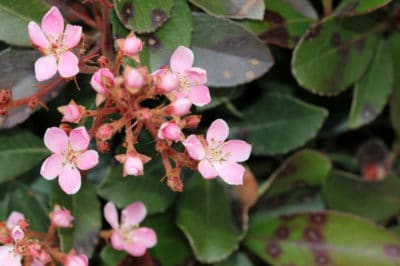Fungal Diseases
Spring may be when Indian hawthorns put on their best show, but it’s also when mild temperatures and regular rain unleash a variety of fungal spores in the garden. What’s frustrating about this arrangement is that fungal disease symptoms frequently don’t surface until well after the original attack.
Entomosporium and Verticillium fungi commonly infect Indian hawthorns.
Entomosporium Leaf Spot
There’s no way around it: Entomosporium fungi love Indian hawthorn leaves. You’ll know they’ve found your shrubs if their leaves have round, red spots. At first, they develop white, spore-filled centers and yellow borders. Without treatment, they merge into dry, dead patches.
Entomosporium spreads when wind or splashing water carries spores from previously infected leaves to healthy ones. It’s most likely to target the shrub’s new spring growth.
Entomosporium Prevention
To prevent an Entomosporium outbreak:
- Plant Indian hawthorns in full sun.
- Use the average widths of two mature shrubs to determine the amount of space between the
- Prune infected leaves and twigs as soon as spots appear.
- Remove fallen leaves promptly.
- Avoid splashing the shrubs when you water.
Verticillium Wilt
Verticillium wilt fungi attack Indian hawthorns through new or damaged roots. When they move through the vascular system, the shrubs respond by producing a gummy substance to block their progress.
The downside is that the gum also keeps moisture and nutrients from moving through the plants. As the summer progresses, their branches wilt. Their leaves wither, curl and turn red or yellow along the veins. On many shrubs, the damage is limited one side.
Verticillium Management
Verticillium wilt is potentially fatal, but these quick actions may save your shrubs:
- Prune their dead branches back several inches below the discolored wood.
- Fertilize with ammonium sulfate at the label’s recommended rate. Scatter it over the soil and water it in.
- Water the shrubs every 10 days to two weeks during dry weather, at the rate of 6 to 12 gallons per 10 square feet of soil.
- Clear the area of weeds. They could harbor the fungus.
Expert gardener’s tip: After working with Verticillium-infested plants, always disinfect your tools to keep them from contaminating healthy ones.
Bacterial Disease
Fire blight bacteria also infect Indian hawthorns during wet, warm springs. They ooze from cankers on dead bark where they’ve spent the winter. Insects and splashing water spread them to the flowers and young foliage, which wilt and blacken as if fire scorched. Untreated plants eventually die.
To prevent an outbreak, remove the cankered branches in winter or summer. Don’t water blooming Indian hawthorns and prune or fertilize them only when absolutely necessary. Too much of either stimulates blight-susceptible new growth.
